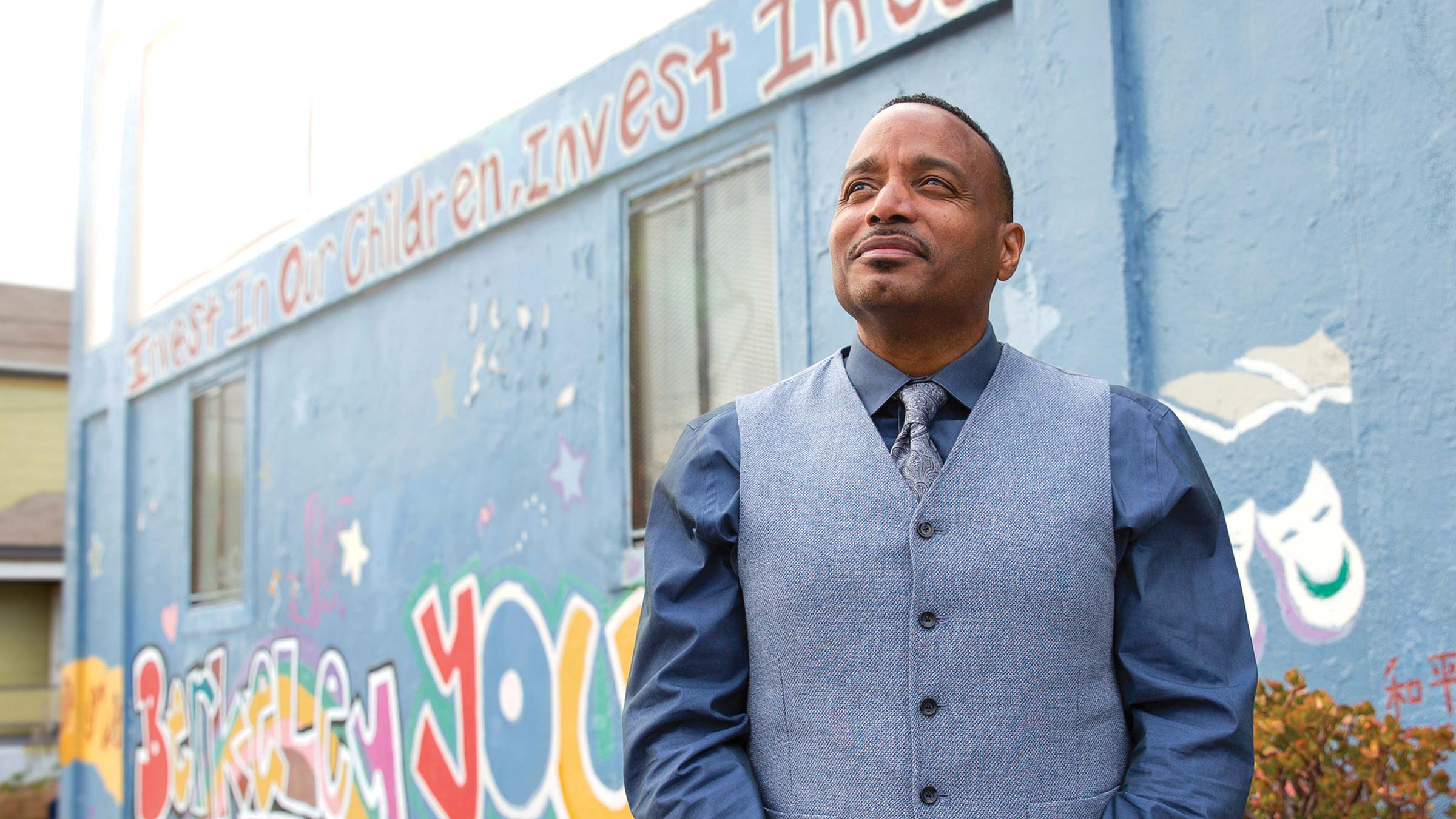“What we’re highlighting is the synergy,” says Institute advisor and University of California, Berkeley economist Rucker Johnson, describing his research on education. “The effects are more than the sum of the individual parts.”
Synergies that can improve lives immediately and across generations are present in much of Johnson’s work. Children of the Dream, his 2019 book, shows that when school integration is combined with investments in pre-K education plus well-funded public schools, racial and socioeconomic achievement gaps diminish.
Synergies can compound shortfalls too. Poor health in childhood exacerbates the ill effects of underresourced schooling, his studies show, and the deficits cascade for decades.
But Johnson is an optimist.
His grandfather, Matthew Johnson Sr., was denied admission to the University of West Virginia because of his race. Undaunted, Matthew got his master’s at Columbia University and taught high school. Later, at the Minneapolis Urban League, he helped expand employment opportunities and affordable housing for people of color.
Rucker Johnson’s father and mother were teachers too, and she became superintendent of schools in Boston, Memphis, and Minneapolis. Johnson—the grandchild also, he emphasizes, of Brown v. Board of Education—is a full professor at one of the nation’s top universities.
Progress is possible, he believes. We talk with Johnson about the struggle, support, and opportunity it will take to get there.
Racial health disparities
Your work documents wide, persistent racial health disparities in the United States. Life expectancy is far shorter for Blacks; for example, hypertension and diabetes are much more prevalent.
Your work also analyzes the origins of those gaps. With Robert Schoeni and Jeannette Rogowski, you found that three-quarters of the Black-White gap in health status at ages over 55 is due to socioeconomic status in childhood, and neighborhood and family factors in young adulthood.
Why are these early-life circumstances so important to health later in life?
It’s really important to understand the various dimensions of inequality and the ways in which they evolve over the life course, but particularly the salience of childhood conditions. Attention is often focused on individual- or family-level responses to health disparities and particularly on medical determinants of health and health care access.
Those things are clearly important, but my work really emphasizes the nonmedical, socioeconomic determinants of health and, in particular, how high levels of segregation undermine not just equal educational opportunity, but access to quality neighborhoods. High levels of segregation are the single biggest driver of racial differences in upward mobility prospects for children. They make the nation less productive. They weaken our economy.
With regard to the strong connection between education and health, they also have significant spillover effects on developmental health trajectories. They mean that exposure to environmental toxins is high and our access to safe and nutritious foods is low. They mean that our children go to underresourced schools and live in high-stress environments. These all have a way of getting under the skin and manifesting much later in life.
It’s only through the lens of longitudinal data where you can follow children from birth to adulthood that you can fully understand these dimensions. So, for example, we documented the long-run consequences and costs of low birth weight and the importance of infant health on subsequent health trajectories. This relates to the fetal origins hypothesis, that when nutritional intake in the womb is limited, the body’s metabolism will be fundamentally altered in ways that show up much later in life—in hypertension, strokes, heart disease.
And so we’re able to look at how the circumstances of childhood affect the magnitude of racial health disparities and document a causal connection between neighborhood quality and family socioeconomic circumstances, and the cascading effects they have on both health and education.
A big part of that work, though, is identifying effective policy prescriptions. One of my favorite Albert Einstein quotes is, “Intellectuals solve problems. Geniuses prevent them.” It’s the way in which we’re able to craft preventive and effective public health and public education investments in children that really has the biggest bang for the buck with regard to promoting healthy development and equal educational opportunity and addressing well-being in ways that are interconnected across education, health, and housing policy. And, of course, early childhood education.
Costs and benefits of incarceration
I wanted to touch on some of your research about incarceration. There are dramatic racial disparities here as well, of course, and you’ve documented that, as well as the consequences of mass incarceration of African Americans.
In a 2012 paper, you look at the impact of incarceration on crime and find that as incarceration rates increased over time, the benefit in terms of crime reduction declined dramatically.
You suggest that these benefits no longer exceeded the financial costs, let alone the indirect costs that you document in other work. Could you tell us more about that research?
Diminishing marginal returns to investment are present in many areas, of course, and incarceration is no different. The premise is that imprisonment prevents crime through an incapacitation effect—it removes offenders from society so they can no longer commit crimes. What we documented is simply that there’s been a shift toward a much higher proportion of nonviolent offenders in prisons as our criminal justice system has not taken a public health and rehabilitative approach to issues of addiction and other kinds of ill. That particular paper in the Journal of Law and Economics is joint with Steven Raphael, a very close colleague of mine.
The early antecedents of criminal involvement are often lack of access to quality public schools and other educational opportunities earlier in life. If we restructure our investment, to educational investments, to health investments, that can actually lead to lower crime costs in the future.
That’s the overarching umbrella of this work. My own research agenda on inequality is motivated by the idea that different forms of inequality and segregation overlap and compound one another with effects that are interactive and reinforcing over the life course.
My work investigates how much the combined effects of early and later childhood education and health investments targeted to poor and minority communities can narrow achievement gaps and adult attainment gaps, including health, by race and class. And do the combined effects exceed the sum of individual policies? One of the key focal areas is, What are the requisite public investments to replace the school-to-prison pipeline with a school-to-life-success pipeline?
Some communities have a disproportionate representation of children who get caught up in school disciplinary actions—suspensions, expulsions—but studies have shown that some of the racial disparities in them are due not only to behavior problems but also to adult perceptions of those kids. The question is, How do schools address those behavioral problems when they manifest?
So part of it is rewinding the clock and thinking about how we can invest better, wiser, and in strategic ways that address that kind of potential to learn and engage in ways that lead to much lower crime costs. When we don’t make those investments, we actually pay for them in the form of increased health care costs, increased criminal justice involvement.

Welfare reform, working mothers, and child well-being
A key objective of welfare reform in the 1990s was to encourage more work effort by aid recipients, but the broader consequences were far more complex and varied. Your 2010 monograph, Mothers’ Work and Children’s Lives, documents the impact of the 1996 welfare reform bill on mothers and their children.
Could you share some of your key findings from that research, in terms of the outcomes for mothers and children? I gather that the quality and stability of mothers’ jobs were crucial determinants of how well children did.
Yes, that research was with Ariel Kalil at the University of Chicago and Rachel Dunifon at Cornell. We started that work while I was getting my Ph.D. at the University of Michigan, when we were all together at Michigan’s Poverty Research Center. It was a project that looked at longitudinal data of mothers who were once on welfare rolls in 1996, but then were followed over a seven-year period in Michigan.
What was important was that we were able to follow not just the mothers’ employment patterns post-welfare reform, but their arduous path to economic self-sufficiency. Most central to our focus was, How did children fare when they had less of a safety net when mothers lost jobs, when mothers experienced significant job instability, when wage growth trajectories indicated a dead-end job instead of upward mobility? Some mothers were working two jobs, full time, through the full year, but still experienced great instability with irregular work hours. And in the 2001 recession, many faced increased housing instability and evictions.
What we were able to document was that given that precarious set of family circumstances, including greater job instability and precarious housing situations, the lack of a significant safety net in the aftermath of the recession resulted in a significant increase in behavioral problems for those children.
That also reflected the lack of quality child care, in a context of single-parent families trying to juggle the balancing act of caring for their families while also setting on an economic self-sufficiency road within an environment of poverty-wage jobs. We have very low minimum wage policy, and we have a preponderance of low-quality, low-wage jobs. Most of those jobs are unstable, with irregular hours, and they don’t pay enough to support a family, particularly in places where housing costs are rising and there’s not additional social support. We found negative consequences for children.
At the time, people were highlighting the 50 percent caseload declines. But they weren’t thinking about the question of, Is it ameliorating poverty?
Since that time, women’s labor force participation has climbed, but the social safety net is more frayed. What are the lessons from this research for what’s happened to low-income mothers and their children over the past decade or so?
That particular research on welfare is relatively old now, but there are still lessons within it for today. Part of it is that we can’t consider only the level of parental income; the composition of that income is also important. That’s particularly true when a significant part of it is reliant on maternal employment patterns without a generous safety net or access to quality health care. For children in particular—when access to health care is tied to mothers’ jobs and the quality of those jobs, or to the jobs of noncustodial fathers—lack of these things is particularly salient for lower-income families and disproportionately so in minority communities.
And in an era of COVID, it’s important to recognize that many whom we consider essential workers are minority women and lower-income women. These are often service sector jobs that are lower wage, with less of a career ladder, but they’re essential to, for instance, the quality of our child care environment. These jobs are essential parts for the recovery of the economy.
We also have so much job dislocation—from schools not reopening, for example. How we respond right now is going to have a significant determination on whether there’s some kind of scarring effect on the developmental trajectories of current generations of children. We need to recognize that child care and quality preschool experiences are not a period of time in the lives of children that you can get back without responding boldly and progressively. Targeted attention is necessary. Impacts are not felt universally or uniformly, but are specifically being experienced more among lower-income and minority communities.
School spending and student achievement
Since the Coleman report in 1966, the conventional wisdom has been that there’s very little relationship between levels of school funding and student achievement.
But 50 years later, in a Quarterly Journal of Economics article with Kirabo Jackson and Claudia Persico, you come to the opposite conclusion. You find that money does matter. You conclude that adult outcomes such as educational attainment, earnings, and poverty levels were strongly related to school spending during their childhood.
Would you elaborate on what you found? Why did increased spending improve outcomes?
It’s important to understand the historical context for a lot of my work on education. Historically, school funding mechanisms have been implicitly tied to long-standing assumptions about which communities and students deserve adequate educational investments. Who has the greatest capacity to learn? Which students do we set high expectations for and hold to high standards versus low expectations and low standards? School segregation and unequal school resources are at the nerve center of inequitable educational opportunity that perpetuates structural racism.

In that research with Kirabo Jackson and Claudia Persico, we were looking at the timing of every state’s court-ordered school finance reform and at the type of funding reform put into place, and then at the way in which its progressivity affected the distribution of school spending.
We joined this policy instrument of court-ordered reforms that took off in the 1970s and ’80s and early ’90s with the student trajectories of kids who were born between 1955 and 1985 and followed them into adulthood. We looked at the conditions they were exposed to in school, what level of resources and spending prevailed in their childhood years, and we followed them all the way through 2015 to document the effects of school spending on educational attainment, from high school graduation rates to college-going rates and college-completion rates, and to earnings, annual incidence of poverty in adulthood, and their likelihood of criminal involvement.
To approach this issue, you can’t use just time-series data aggregated at the state level or national data. Instead, it requires looking at nationally representative micro data over an extended time period, where you’re able to use longitudinal, individual- level data matched with the school policies and reform environment in which students were growing up, and having detailed information on parental and family background.
Also, a lot of these policies were compensatory, meaning they were targeted toward more disadvantaged families and communities. If you don’t take that preexisting disadvantage into account, you will end up understating the significant cascading positive effects of these infusions of spending into school districts in terms of how it affected school quality.
There are long-standing arguments that school desegregation was a failed social experiment, that school spending doesn’t matter, that pre-K is ineffective on long-term outcomes. Not one of those arguments is borne out by the facts when you use longitudinal data and a research design that can isolate the independent effect of a policy reform from other things that are changing. In my book, Children of the Dream, I document that where we failed was in not sustaining those efforts to integrate our schools, to invest in them equitably, and to begin with investment in the pre-K years.
You found that for low-income children, a 10 percent increase in per pupil spending per year was associated with about a half an additional year of education, roughly 10 percent higher earnings, and a 6-percentage-point reduction in the annual incidence of adult poverty.
What mechanisms were operating here? What is the link between school spending and better outcomes many years later?
Looking at the mechanisms is an important part of figuring out why school resources matter and why per pupil spending matters. How much of that goes to class size reductions, increases in teacher salaries, additional guidance counselors, resources for socioemotional learning and development? There are various dimensions about how school spending and structural support affect outcomes.
Today, about 75 percent of per pupil spending disparities are between states (rather than between districts within states). And we’ve witnessed that inequality in school spending has risen since 2000. After three decades of narrowing—the ’70s, ’80s, and ’90s—primarily due to the state school finance reforms emphasized in my work with Kirabo Jackson and Claudia Persico, there has been a significant rise in inequality, especially sharply following the Great Recession.
What I want to highlight here is the current disparities nationwide in school resources. School districts with the most students of color have about 15 percent less per pupil funding from state and local sources than predominantly White, affluent areas, despite having much greater need due to higher proportions of poverty, special needs, and English language learners.
Teacher quality is often the missing link that people don’t consider directly when thinking about school resource inequities. For example, schools with a high level of Black and Latino students have almost two times as many first-year teachers as schools with low minority enrollment. And minority students are more likely to be taught by inexperienced teachers than experienced ones in 33 states across the country.
It’s directly tied to our heavy reliance on the local property wealth to fund local schools. That dependence on the local property base and wealth leads to significant differences in access to quality schools. Basically, the housing market rations access to quality schools.
Housing prices are as much an indication of the quality of schools in those areas as the number of bedrooms or the square footage of a house. By that, I mean that it’s being capitalized into housing prices. Part of it is that the invisible lines of school district boundaries are powerful tools of segregation. It’s a way of segregating and hoarding access to opportunity. And when I say access to opportunity, I mean quality of teachers, I mean curricular opportunity.
For example, only a third of public schools with high Black and Latino enrollment offer calculus. Courses like that are gateways to majoring in STEM in college and having a STEM career. Or simply the fact that less than 30 percent of students in gifted and talented programs are Black or Latino. Part of that is the racialized tracking of kids that happens as early as the third grade and puts them into college preparatory tracks versus noncollege preparatory tracks quite early. And, again, racial disparities in parental wealth and racialized tracking can thwart the realization of equal educational opportunity.
These are things that happen very early in students’ school careers that policy can do much to ameliorate. Otherwise, these schools end up becoming breeding grounds for the achievement gaps that emanate from the intersection of race, place, and parental wealth in childhood.
Pre-K investment and school finance reform
The Minneapolis Fed has a long-standing interest in early childhood education, so I was especially drawn to your 2019 article with Kirabo Jackson on “dynamic complementarity” between investments in early childhood and spending at schools.
You examine the rollout of Head Start alongside the staggered implementation of school finance reform and analyze outcomes for people born between 1950 and 1976.
Would you tell us about your findings? I was especially struck by one statement in that paper: “The complementarities imply that one could increase both equity and efficiency by redistributing spending from well-funded K-12 schools toward Head Start programs targeted at poor children.” Economics rarely finds gains of that sort.
People often have an either/or mindset—is it pre-K or is it K-12? And discussion is very often siloed, so solutions pit pre-K versus K-12, or health investment versus educational investment.
What we’re highlighting is the synergy. Our existing approaches to what ails the education system often detach pre-K from K-12, health investments from educational investments. Education often intersects with housing but, in policy, they’re often treated separately.
But it’s not just the collection of good policies that matters; it’s the collaboration of policies that makes the difference. The reason is that there are significant synergistic effects that are more than the sum of the parts.
For example, it’s been documented that half of the achievement gap that we observe among third graders was apparent at kindergarten entry. What that reflects, in part, is the strong footprint of early childhood experiences. And that’s why access to quality pre-K can play a significant role, particularly in the lives of lower-income children. Without those public investments in early pre-K programs, they would often not have access to environments that promote nurturing interpersonal relationships and school readiness.
What’s important about this is that during the initial rollout of Head Start, the first 15 years, those programs also significantly improved health, child health. This was because immunizations increased, the quality and continuity of pediatric care significantly increased. This predated a lot of the significant public investments in Medicaid expansions. Partly, it’s that healthier children are better learners. Again, there’s that connection between education and health, pre-K and K-12.
What we’re able to do in that research is leverage the per pupil spending in pre-K programs and the timing of that set of increases at the county level, link it to the student level of children we’re following from birth to adulthood, and connect that with the level of school resources in their K-12 years via the court-ordered timing of school funding reforms in their state and district of upbringing.
When we put those pieces together, we found that it was not just that public pre-K spending via Head Start has significant long-term beneficial effects. And it wasn’t only that the K-12 spending has significant positive effects. What we found was that there was a significant synergy; we call it dynamic complementarity.
We found that when children attend poorly funded K-12 environments, the long-term effects of pre-K tend to dissipate. It’s consistent with the fade-out effect that other people have documented. It’s only when the pre-K investments are followed with quality K-12 investments—where they’re going to schools that are well-funded and well-resourced—that we see sustained, positive effects of pre-K spending.
Similarly, the effectiveness of K-12 spending is enhanced significantly when it’s preceded by quality pre-K access. In their K-12 years, children are more prepared to learn and to take advantage of the educational opportunities that occur in those K-12 years. When we do them in concert, the effects are more than the sum of the individual parts.
Tennessee did a major expansion of their public pre-K, but funding for K-12 there is regressive. Many kids who had access to pre-K subsequently went to less-well-funded K-12 schools, and the effectiveness of the pre-K investment did not translate into sustained beneficial effects beyond the elementary school years. Again, that’s evidence of the dynamic complementarity—you need both of those effective bits to succeed.
School integration
In Children of the Dream, you make a powerful argument for improving the nation’s educational system through school integration, quality preschool, and school finance reform, and you refer to this as a “three-dimensional synergy.” You’ve just reviewed some of the evidence on the latter two—quality preschool investment and K-12 spending.
Could you explain why integration is the crucial third element?
We shouldn’t throw money at these problems without understanding first that segregated environments make it much more difficult to equalize opportunity. When we have concentrations of poverty, equal spending is not equal if the need is far greater. The cost of providing equal programming differs across schools that have very different concentrations of need.
What we’re finding is that we should be concerned about promoting integration for reasons that go beyond test scores. There are issues around how children learn in integrated environments, about learning across differences, and about the value of diversity in schools. We’re able to show that this has an impact on kids’ long-term attitudes along race, including racial attitudes expressed in adulthood. This is particularly true among non-Hispanic, White children who did not grow up in a diverse school environment, who were highly segregated.
So we’re not just documenting positive effects of school resources and pre-K investments for lower-income and minority children, though those disproportionately have those effects there, but we’re also documenting that more integrated environments have beneficial effects for all kids.
These are things that are not captured by test scores alone, but they have a vast impact on society in the long run. Our schools are like a microcosm of the kind of social ills that we confront many years down the road.
We’re now experiencing the resegregation of our nation’s public schools, where 40 percent of Black students and 42 percent of Latino students attend schools where less than 10 percent of their peers are non-Hispanic White.
By analyzing data on children followed into adulthood, I find that the resegregation of public schools has contributed to the increases in racial bias, racial intolerance, and rising polarization of political views that we observe expressed in adulthood. These effects, rooted in a lack of exposure to racial/ethnic diversity in schools, are most pronounced among White Americans. Not only that, but children in these schools struggle to develop the ability to empathize with others and to appreciate the validity of other cultures. For African Americans, our results show that confinement to segregated, poorly funded schools interferes with children’s life chances.
Children of the Dream refers to this as “our collective retreat from integration” from a peak in school integration in the late 1980s. And in a 2015 talk at Howard University for the National Coalition on School Diversity, you said that retreat is “leaving in its wake a growing achievement gap by class, a stubbornly large one by race.”
Could you say more about the mechanisms behind this resegregation?
We’re in an era where the vast share of school segregation is due to housing segregation, including subsidized housing and disproportionately concentrated poverty neighborhoods.

And, today, two-thirds of segregation occurs between school districts, not within them. In the earlier era, a significant part of segregation occurred within district boundary lines. Once the majority of segregation is between districts, it becomes much more imperative to use tools beyond busing to integrate schools. In this respect, housing policy is central.
The United States spends $44 billion a year on affordable housing programs, but that funding tends to be concentrated in high-poverty, low-opportunity neighborhoods, particularly among families with children. That is one of the primary reasons that the two areas that have the biggest impacts on opportunity for children are education and housing. And yet those are the areas in which civil rights has made the least progress, due to segregation.
Sometimes people have the impression that this is about parents’ choices and that policy is not implicated in this. But, actually, this is the direct consequence of explicit policies. There are a large number of gerrymandered school district boundaries. There are ways in which parents with wealth, particularly and unfortunately non-Hispanic White parents with wealth, have used their political influence to create school assignment zones that are more segregated along race and class lines to basically hoard opportunity.
When we’re talking about segregation, it’s not just the separation of school children by race. Integration is not only about the assignments of children to schools by race, but it’s definitely about equitable use of resources; that includes funding, teacher quality, teacher diversity, multicultural curriculum, and curricular quality. I just talked about racialized tracking in the discussion on school finance reform.
We document that the longer students are treated for the symptoms of segregated, poorly funded education via school integration as well as school funding reform, the better the outcomes. The higher the dose of integration and funding reform they receive, the better their long-term outcomes are.
We’re documenting that school funding reform alone is insufficient to fulfill the promise of equal educational opportunity. There could certainly not be a cure without it, but it’s not the full cure. It has to be combined with school integration and expansion of access to high-quality pre-K. That three-dimensional synergy is precisely the policy prescription that I believe the nation needs to implement in order to overcome the legacy of segregation. So there’s no single panacea, but when we combine these efforts, we’ve seen children’s life trajectories fundamentally altered in all of the most positive ways.
California’s school funding formula
You’ve studied the impact of school funding reforms in California, and I know you’re working on a new piece of research on the state’s local control funding formula. Part of its importance derives from sheer numbers. California’s is the largest state system, with one of every eight of the country’s public schoolchildren; it’s also a very diverse population. Could you tell us about this current work?
California’s local control funding formula was the most significant major school funding reform in a generation in California. Passed by the legislature in 2013, it included a new commitment of $18 billion to the public education system that was not targeted by property wealth—that is, local property taxes weren’t dedicated to local schools—but targeted to student need as defined by disadvantage. The funding formula became much more progressive.
We were able to leverage the whole universe of public schoolchildren data, at the student level, of all children born since 2000. The funding rolled out over a 7-year period, starting in 2013, and was fully funded by 2018-19. Because of this phase-in of funding, we were able to isolate the ways in which school spending increases affected student learning outcomes, and we could do it in every subject, for every grade, including outcomes like high school graduation rates. And we measure those academic achievement measures against the national benchmarks (National Assessment of Education Progress, often referred to as the “nation’s report card”). Also, we were able to account for family background and other factors that would otherwise confound our ability to isolate the causal impact of school spending.
And what did we find? For this infusion of spending targeted to lower-income districts, we find that students in every grade experienced significant improvement in math and reading outcomes. We see significant narrowing of achievement gaps by race and poverty. And we see that every school that experienced this increase of dollars found beneficial effects from that spending.

A lot of school leaders are making decisions now about the new influx of federal money coming from the American Rescue Plan, and this is the first study that documents the impact of not just levels of spending, but the types of spending that matter most for boosting learning outcomes throughout the K-12 years.
We’re really excited about the timeliness of the work and being able to document impacts for every grade, every year, and every school. Our next effort is to decompose those impacts to get at the mechanisms and pathways. By that I mean, what had the most impact on learning outcomes, from reductions of class size, higher teacher salaries, more guidance counselors, and other support systems for kids, as opposed to, say, building renovations or administrative salaries.
Now, in this COVID environment, some of the building infrastructures need to be upgraded to have proper ventilation systems. Obviously, responding to COVID increases the cost of finding healthy environments for kids to learn, because of distance learning and not having overcrowded classrooms, and doing so in ways that support lower-income and minorities. This targeted funding from the American Rescue Plan is going to be essential, and it’s going to be essential that we pair that with the best evidence on how money matters, not just that money matters.
Expanding opportunity
The mission of the Opportunity & Inclusive Growth Institute is to expand opportunity. What does that mean to you at a personal level?
I think that what we’re really saying in some way is that hoarding opportunity and not investing in the full potential of all kids impacts all of us. And the question is whether we’re going to embrace public education in a way where the public mission of education is to provide equal opportunity along curricular dimensions, along funding dimensions, to developing and retaining quality teachers, and paying them their worth with regard to how they’re one of the most important aspects of students’ learning and their life trajectory.
I am fortunate to have had access to some of the best teachers and education opportunities, and I had wonderful parents who were able to invest so much—they believed in me, when I certainly didn’t have all the abilities to secure or even fight for those opportunities.
So the question is, How do we enlarge our discussion to not have conversations focused on budget deficits, but rather deficits of opportunity? We need to focus on children from disadvantaged backgrounds and how we intervene to remediate that disadvantage.
What I want to highlight that’s relevant for this moment is that COVID has been a revealer and an accelerator of opportunity gaps that already existed. How we respond to this moment will dictate whether there’s a scarring effect for a generation of children or whether this is the reset button to a new normal that takes integration seriously. The American Rescue Plan package includes $128 billion for K-12 education and hundreds of millions for state governments. It represents the single biggest federal outlay for public education and K-12 in our history. And the fact that almost $110 billion is flowing to districts through Title 1—again, that’s targeted to lower income districts—means that it’s imperative that we apply the best-informed evidence about why money matters so that we can target those learning loss mitigation funds to the students whose needs are greatest.
I really appreciate what the Institute is doing, its mission, the importance of documenting not just dimensions of inequality, but healthy prescriptions for social change, across education, health, criminal justice system—the full gamut.
And I’m thankful for your engagement with my research in this forum. There are a lot of challenges that we face, and the Institute is a true leader in connecting across the research, practice, and policy continuum to expand opportunity for all kids. That is really what I am most excited about in being a part of the Institute board.







